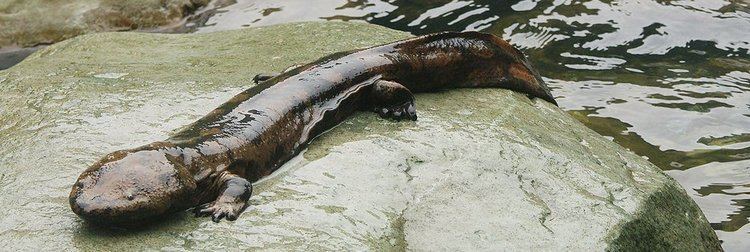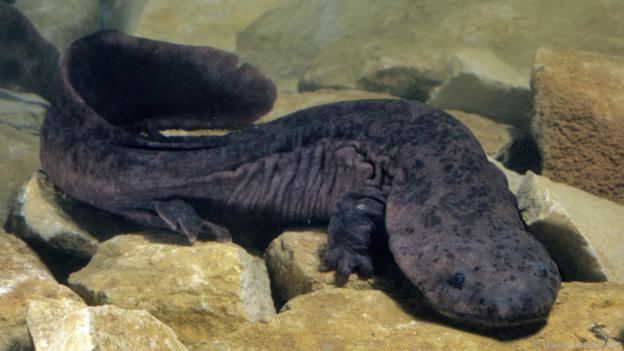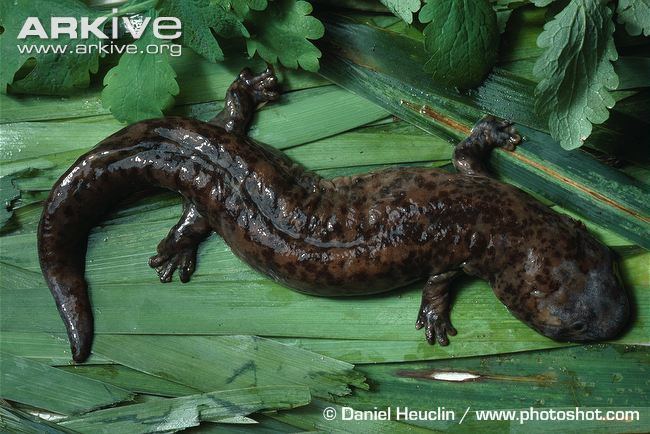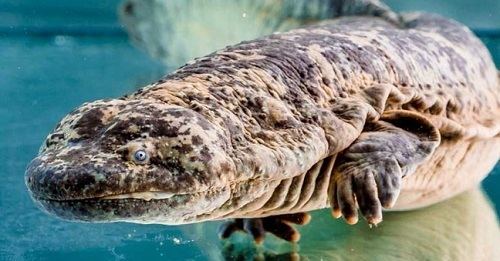Order Caudata Mass 25 – 30 kg (Adult) | Family Cryptobranchidae Scientific name Andrias davidianus Length 1.2 m (Adult) Clutch size 400 – 500 | |
 | ||
Similar | ||
The Chinese giant salamander (Andrias davidianus) is the largest salamander and largest amphibian in the world, reaching a length of 180 cm (5.9 ft), although it rarely reaches that size today. It is fully aquatic and is endemic to rocky mountain streams and lakes in China. It has been introduced to Kyoto Prefecture in Japan and possibly Taiwan. It is considered critically endangered due to habitat loss, pollution, and overcollection, as it is considered a delicacy and used in traditional Chinese medicine. It has been listed as one of the top 10 "focal species" in 2008 by the Evolutionarily Distinct and Globally Endangered (EDGE) project. The Chinese giant salamander is considered to be a "living fossil." Although protected under Chinese law and CITES Appendix I, it is estimated that the wild population has declined by more than 80% since the 1950s.
Contents
- Chinese giant salamander world s largest amphibian
- Taxonomy
- Description
- Feeding
- Breeding and life cycle
- Distribution and habitat
- Farming
- In zoos and aquariums
- Decline in population
- Habitat destruction
- Climate change
- Overhunting
- Conservation efforts
- References

Chinese giant salamander world s largest amphibian
Taxonomy

The correct scientific name of this species has been argued to be Andrias scheuchzeri (in which case Andrias davidianus would be a junior synonym) – a name otherwise restricted to an extinct species described from Swiss fossils. It has also been given the moniker of "living fossil" for being part of the family Cryptobranchidae which dates back 170 million years. It is one of only three extant species of the family, the others being the slightly smaller, but otherwise very similar Japanese giant salamander (Andrias japonicus), and the far smaller North American hellbender (Cryptobranchus alleganiensis).
Description

It has a large head, small eyes, and dark and wrinkly skin. Its flat, broad head has a wide mouth, round, lidless eyes, and a line of pair tubercles that run around its head and throat. Its color is typically dark brown with a mottled or speckled pattern, but it can also be other brownish tones, dark reddish or black. Albinos, which are white or orange, have been recorded. All species of giant salamander produce a sticky white skin secretion that repels predators.

The average adult salamander weighs 25–30 kg (55–66 lb) and is 115 cm (3.77 ft) in length. It can reach up to 50 kg (110 lb) in weight and 180 cm (5.9 ft) in length, making it the largest amphibian species. The longest recently documented Chinese giant salamander, kept at a farm in Zhangjiajie, was 180 cm (5.9 ft) in 2007. At 59 kg (130 lb), both this individual, and a 140 cm (4 ft 7 in) long, 52 kg (114 lb) individual found in a remote cave in Chongqing in December 2015, surpassed the species' typically reported maximum weight.

The giant salamander is known to vocalize, making barking, whining, hissing, or crying sounds. Some of these vocalizations bear a striking resemblance to the crying of a young human child, and as such it is known in the Chinese language as the "infant fish" (娃娃鱼 / 鲵).
Feeding

The Chinese giant salamander has been recorded feeding on insects, millipedes, horsehair worms, amphibians (both frogs and salamanders), freshwater crabs, shrimp, fish (such as Saurogobio and Cobitis) and Asiatic water shrew. Presumably ingested by mistake, plant material and gravel have also been found in the stomachs of Chinese giant salamanders. Cannibalism is frequent; in a study of 79 specimens from the Qinling–Dabashan range, the stomach content of 5 included remains of other Chinese giant salamanders and this made up 28% of the combined weight of all food items in the study. The most frequent items in the same study were freshwater crabs (found in 19 specimens), which made up 23% of the combined weight of all food items.
It has very poor eyesight, so it depends on special sensory nodes that run in a line on the body from head to tail. It is capable of sensing the slightest vibrations around them with the help of these nodes. Based on a captive study, most activity is from the earlier evening to the early night. Most individuals stop feeding at water temperatures above 20 °C (68 °F) and feeding ceases almost entirely at 28 °C (82 °F). Temperatures of 35 °C (95 °F) are lethal to Chinese giant salamanders.
Breeding and life cycle
Both sexes maintain a territory, averaging 40 m2 (430 sq ft) for males and 30 m2 (320 sq ft) for females. The reproductive cycle is initiated when the water temperature reaches 20 °C (68 °F) and mating occurs between July and September. The female lays 400–500 eggs in an underwater breeding cavity, which is guarded by the male until the eggs hatch after 50–60 days. When laid, the eggs measure 7–8 mm (0.28–0.31 in) in diameter, but they increase to about double that size by absorbing water. When hatching, the larvae are about 3 cm (1.2 in) long and external gills remain until a length of about 20 cm (8 in) at an age of 3 years. Maturity is reached at an age of 5 to 6 years and a length of 40–50 cm (16–20 in). The maximum age reached by Chinese giant salamanders is unknown, but it is at least 60 years based on captive individuals. There have been undocumented claims of 200-year-old Chinese giant salamanders, but these are considered unreliable.
Distribution and habitat
The Chinese giant salamander was widespread in central, south-western and southern China, but its range is now highly fragmented. Its range spans the area from Qinghai east to Jiangsu and south to Sichuan, Guangxi and Guangdong; notably in the basins of the Yangtze, Yellow and Pearl Rivers. Finds in Taiwan may be the result of introduction. Chinese giant salamanders have been introduced to the Kyoto Prefecture in Japan where they present a threat to the native Japanese giant salamander, as the two hybridize.
The Chinese giant salamander is entirely aquatic and lives in rocky hill streams and lakes with clear water. It typically lives in dark muddy or rocky crevices along the banks. It is usually found in forested regions at altitudes of 100 to 1,500 m (300 to 4,900 ft), with most records between 300 and 800 m (1,000 and 2,600 ft). There is an isolated population at an altitude of 4,200 m (13,800 ft) in Qinghai, but its taxonomic position is uncertain and the site likely does not support giant salamanders anymore due to pollution.
The salamanders prefer to live in streams of small width (on average, 6.39 m or 21 ft across), quick flow, and little depth (on average, 1.07 m or 3 ft 6 in deep). Water temperature varies depending on season, with typical range at low elevation sites being from 10 to 25 °C (50 to 77 °F) and at high elevation sites from 3 to 20 °C (37 to 68 °F). Although they prefer to have quick flow in the stream, the burrows in which they lay their eggs often have much slower flow. Furthermore, their habitat often possesses very rocky, irregular stream beds with a lot of gravel and small rocks as well as some vegetation. Chinese giant salamanders are also known from subterranean rivers. As populations in aboveground rivers and lakes are more vulnerable to poaching, there are some parts of China where only the subterranean populations remain.
Farming
Very large numbers are being farmed in China, but most of the breeding stock are either wild-caught or first-generation captive-bred. This is partially explained by the fact that the industry is relatively new, but some farms have also struggled to produce second-generation captive-bred offspring. Registrations showed that 2.6 million Chinese giant salamanders were kept in farms in 2011 in Shaanxi alone, far surpassing the entire countrywide wild population estimated at less than 50,000 individuals. Shaanxi farms (mainly in the Qinling Mountain region) accounted for about 70% of the total output in China in 2012, but there are also many farms in Guizhou and several in other provinces. Among 43 south Shaanxi farms surveyed, 38 bred the species in 2010 and each produced an average of c. 10,300 larvae that year. Farming of Chinese giant salamanders, herbs and mushrooms are the three most important economic activities in Shaanxi's Qinling Mountain region, and many thousand families rely on the giant salamander farms for income. The giant salamander farming mainly supplies the food market, but whether this can be achieved to an extent where the pressure on the wild populations is reduced is doubtful. Release of captive-bred Chinese giant salamanders is supported by the government (8,000 were released in Shaanxi in 2011 alone), but represent a potential risk to the remaining wild population, as diseases such as Ranavirus are known from many farms. Additionally, release of untreated wastewater from farms may spread diseases to wild Chinese giant salamanders.
In zoos and aquariums
As of early 2008, ISIS records only show five individuals held in US zoos (Zoo Atlanta, Cincinnati Zoo, and Saint Louis Zoological Park), and an additional four in European zoos (Dresden Zoo and Rotterdam Zoo). A medium-sized individual, approximately 3 ft (0.9 m) long, was kept for several years at the Steinhart Aquarium in San Francisco, California, and is now on display again in the "Water Planet" section of the new California Academy of Sciences building. There are also two in residence at the Los Angeles Zoo. Additional individuals are likely kept in non-ISIS zoos and animals parks in its native China, such as Shanghai Zoo. Several of them are kept in the aquaria of Shanghai and Xian. The Osaka Aquarium Kaiyukan in Japan has both a Chinese and a Japanese giant salamander on display, as does the Saitama aquarium in Hanyu city, Saitama prefecture.
Since May 2014 thirty-three Chinese giant salamanders including three adults have been held in Prague Zoo. The main attraction is the largest individual in Europe, which is 155 cm (5 ft 1 in) long.
Decline in population
In the past, the Chinese giant salamander was fairly common and widespread in China. Since the 1950s, the population has declined rapidly due to habitat destruction and overhunting. It has been listed as Critically Endangered in the Chinese Red Book of Amphibians and Reptiles. Despite the Chinese Government listing the salamander as a Class II Protected Species, 100 salamanders are hunted illegally every year in the Hupingshan Natural Nature Reserve alone. Since the 1980s, 14 nature reserves have been established as an effort to conserve the species. Despite this, the population continues to decline with the salamanders becoming increasingly difficult to find. In a recent survey of the species in the Qinghai Province, none were found indicating the population size is at a significantly low number or the species is locally extinct in the province. This is believed to be due to the increased mining in the region.
In recent years populations have also declined with an epizootic Ranavirus infection. The disease causes severe hemorrhaging in both juveniles and adult salamanders. The virus was Chinese giant salamandersnamed the Chinese giant salamander iridovirus (GSIV).
Its natural range has suffered in the past few decades due to habitat loss and overharvesting. Consequently, many salamanders are now farmed in mesocosms across China. Furthermore, previously built concrete dams that destroyed the salamander's habitat are now fitted with stairs so that the animal can easily navigate the dam and make it back to its niche.
The Chinese giant salamander is listed as a critically endangered species. It has experienced a drastic population decline, which is estimated to be more than 80% in the last 3 generations due to human causes. Human consumption is the main threat to the Chinese giant salamander. They are considered to be a luxury food item, as well as an important source of traditional medicines in China. They are easy to hunt, so catching them is not a problem. Breeding Chinese giant salamanders is a large industry with thousands of breeding and many enterprises.
Habitat destruction
According to a recent study, 90% of the Chinese giant salamanders' habitat was destroyed by the year 2000, and there are many human-related causes of such massive destruction. Because the salamander dwells in free-flowing streams, industrialization is a large problem for many stream-dwelling species. The construction of dams greatly disturbs their habitat by either causing these streams to dry up or to stand still, thus making it uninhabitable by the salamanders. Siltation also contributes to the degradation of their habitats by soiling the water. Deforestation in areas near the streams can worsen soil erosion and create runoff into the streams as well, which reduces the water quality to a great extent. The reduced water quality makes it much more difficult for the salamanders to absorb oxygen through their skin and can often bring death to those within the species.
Water pollution is also a great factor in the habitat destruction of the Chinese giant salamander; the immense decline in their population can be traced to, among the other major problems of over-hunting and failed conservation efforts, the tainting of the water that they live in. Mining activity in particular in areas near their streams often causes runoff that sullies the water, and farming—and all of the pesticides and chemicals that affect the soil that come with it—has a vastly negative effect on the areas near the streams as well. The presence of macronutrients in the streams can also cause algal blooms, which cloud the water and force the temperature to rise. The salamanders reside primarily in very cold underwater cavities and follow a specific nesting requirement, which means that they will only reproduce and care for their eggs in areas such as these, so changes in temperature are incredibly detrimental to their health and well-being as well as to their perpetuation as a species. These algal blooms also deplete the levels of oxygen in the water, and a lesser supply of oxygen can quite easily hold the potential to kill off many members of the dwindling species.
Many efforts have been undertaken to create reserves and faux habitats for the Chinese giant salamander so that they can reproduce without worry of soiled water, but many of these reserves have failed in having a great impact overall due to the massive overhunting of the species. No matter how many members of the species they manage to save through the reserves, the poachers still manage to capture and kill that many more. Although habitat destruction is certainly not assisting in the perpetuation of the species, it is certainly not the biggest obstacle that the Chinese giant salamander faces in its quest to avoid extinction.
Climate change
Like other amphibians, the Chinese giant salamander is cold-blooded. Most Chinese giant salamanders stop feeding at water temperatures above 20 °C (68 °F) and feeding ceases almost entirely at 28 °C (82 °F). Temperatures of 35 °C (95 °F) are lethal to Chinese giant salamanders. As a consequence, the species is vulnerable to global warming.
Overhunting
Many different amphibian species in China have been placed under threat by the International Union for Conservation of Nature, or the IUCN. One of the main reasons that the Chinese giant salamander, Andrias davidianus, has been placed on the critically endangered list is the overhunting of the amphibian. In 1989, the Chinese government placed legal protection on the salamander, but for the next 15 years it continued to decline. Overall, amphibians worldwide are declining in population for many reasons, especially in China, where 84% of species of amphibians are being affected in some way by overhunting even while attempts to conserve them are being made. The Chinese giant salamander is a main example of one of these amphibians that have been in this type of decline primarily due to over-harvesting, which has great effects on the species' diversity and the conservation efforts. Overhunting overall in China is a major threat to all species in the country. In China specifically, 75% of native species in China are harvested for food. The salamander is also used for its traditional use for medicinal purposes. The demand for the use for these creatures as food in China greatly exceeds the number that can be harvested from the wild. Commercial captive breeding is looking to be the future for providing this demand to the Chinese people, but this will also have little impact on the over-harvesting threat. The profits made from the hunting and selling of the salamander will keep it as a lucrative business venture for poachers. The Chinese giant salamander also has a great value for scientists due to research possibilities for phylogenetic and physiological aspects.
China's penalty for illegally hunting these creatures is also very low and only comes to 50 yuan, which translates to US$6. The value of these salamanders is much more than that. Salamanders are worth $100 to $150 per kg. Illegally caught salamanders are then distributed and sold to establishments such as restaurants which then charge $250–$400 per kg. These only encourage the hunting of these endangered salamanders and is the primary reason why stopping the hunting of these creatures is so challenging. A hunting tool known as a bow hook is one of the preferred methods used by hunters to catch the salamander. This hunting tool is made with a combination of bamboo and sharp hooks baited with frogs or smaller fish. This is used to capture the salamander and keep it alive. Some hunters use pesticides to kill the salamander. The population has since been assigned category II due to its population decline by The Wild Animal Protection Law of China and Appendix I in the Convention of Endangered Species of Wild Fauna.
Conservation efforts
To understand the conservation efforts in China, it is important to know something about the events of the several past hundred years of China's history relating to social attitudes, pressures on nature and natural resources, and the political ambition to safeguard the natural environment. Each of these are significant factors and determinants of conservation efforts. Up until the year 1700, China was a country that was rampant with land reclamations, growing land exploitation, and wars. These series of events led to a huge upsurge in the diminishing of the natural biomass and as well as a reduction in spatial distribution of biotic resources. The significance of this situation was that this drastic dwindling of resources made the people of this region aware of the relationship between utilization and conservation. From 1911 to 1949, China began to move into the direction of modern industry, urbanization, civil wars, and agriculture. This transition period brought with it the depletion and disappearance of various renewable resources, as well as the pollution of various biotopes. This lack of conservation eventually led to a deteriorating environment, which meant lower standards of living for the Chinese human population. This is the point when both the government and the people of China came to the epiphany that the environment matters. It was not until 1956 that modern nature conservation efforts begin to develop.
The Chinese reforms that preceded this new Chinese perspective on conservation were not only beneficial to the Chinese giant salamander, but all organisms that occupied the natural environment of China. There was a formation of a new administrative system for nature conservation, which came together in the late 1950s. This new structure was able to establish new regulations that aimed at being successful in educating the masses about the value and significance of nature conservation, promoting awareness on the present status of various species, as well as prohibiting anti-conservation efforts such as hunting and trading of protected species such as the Chinese giant salamander. Some examples would be the Environmental Protection Law of 1979, Regulation of Water and Soil Conservation of 1982, Forestry Law of 1985, as well as the Wildlife Conservation Law of 1988. It was during this time period that the Chinese giant salamander was categorized as a category II species. All these species are endangered because their population is declining or their geographic distribution is becoming restricted.
In the midst of all these conservation efforts being conducted, in the late 1970s, a programme network of nature reserves was established in China. These reserves were established to uphold four major principles. First, is to conserve typical ecosystems and to represent the biotic communities. Second, the reserves are meant to secure rare, endemic and valuable species, as well as their habitats or breeding locations. Third, these reserves were developed to rescue and regenerate deteriorated or damaged natural ecosystems and habitats of special significance. Finally, the reserves would be created in order to have sanctuaries in areas of special importance, such as seed forests, geological sections, glacial remains, watershed forest, etc. Many of these reservations were created for the overall protection of all endangered species of China and the conservation of the natural world they occupy. A few more reservations were made specifically with the idea of preserving Chinese giant salamander populations. Beginning in the 1980s, there have been more than 14 nature reserves established for the conservation of the Chinese giant salamander. Examples would be the Zhangjiaje Giant Salamander Nature Reserve, Lushi Giant Salamander Nature Reserve, Qingyaoshan Giant Salamander Nature Reserve, Youyang Giant Salamander Nature Reserve, and the Taibai Giant Salamander Nature Reserve.
Though many efforts have been put forward, very few regulations have been actually been enforced. Due to lack of strong influential regulations and lack of funding, the conservation of the Chinese giant salamander has all but failed. They continue to have major decline in their populations due to human intervention of many different sorts. Even nature reserves continue to see diminution of populations. Many of the reserves suffer from the same issues, such as shortage of funding and personnel, poaching, development of tourism, etc. Few believe that even with the major losses already suffered, things can still be turned around through proper protection of the Chinese giant salamander habitats, nesting sites, prevention of pollution from run-off, banning of certain hunting methods, and an assessment of irrigation work with nature reserves. Some believe that there also need to be more surveys carried out that institutes the Conservation status and demography of the salamander, as well as having a holistic view of the life history of this species. Others say that a public information campaign is needed to better educate local inhabitants.
Construction has begun on the largest artificial breeding and protection base for the endangered giant salamander in China. The base in Jing'an County, in the eastern province of Jiangxi, will breed the amphibians for scientific research, the traditional Chinese medicine industry and for exhibition in aquariums. Located in the Sanzhaolun Forest Park, the 10.83 million yuan (1.35 million U.S. dollars) project is intended to breed 60,000 giant salamanders annually when it is completed by the end of next year. The base, covering 10,000 square meters, would boost efforts to save the world's largest amphibian from extinction, said Li Xinfa, head of the Jing'an County Giant Salamander Research Center. The number of wild giant salamanders has declined rapidly due to their value as a source of traditional Chinese medicine ingredients and as food, and due to poaching, loss of habitat and pollution. It has been put on the list of the Convention on International Trade in Endangered Species, and it is under state protection in China. EDGE (Evolutionarily Distinct & Globally Endangered) aims to ensure the future of this salamander by helping to create an environmental education programme encouraging sustainable management of wild populations.
